
Treatment with the investigational anti-IgE biologic ligelizumab was generally effective in patients with H1 antihistamine-unresponsive chronic spontaneous urticaria (CSU) who did not achieve complete symptom control with omalizumab (Xolair), an exploratory analysis of a phase IIb extension study showed.
In a subset of omalizumab-treated patients with a score greater than 0 on the 7-day urticaria activity score (UAS7) at week 12 during the initial part of the study, re-treatment with ligelizumab during an extension phase was associated with numerically greater response at all time points, reported Gordon Sussman, MD, of the University of Toronto.
“Ligelizumab re-treatment exhibited added benefit of better urticaria control versus omalizumab, especially in those patients who did not achieve complete responses with omalizumab in the phase IIb core study,” Sussman said during a presentation at the virtual American College of Allergy, Asthma & Immunology (ACAAI) meeting.
Among these 37 patients, the mean change from baseline in UAS7 with 300 mg omalizumab versus 240 mg ligelizumab, respectively, was:
- Week 1: -6.02 vs -9.39
- Week 4: -12.79 vs -16.49
- Week 8: -15.91 vs -17.19
- Week 20: -13.87 vs -20.29
Responses to omalizumab were slower and plateaued by week 8, while improvements with ligelizumab continued through week 52, Sussman and colleagues reported in their study abstract.
CSU is characterized by itchy hives, allergic swelling (angioedema), or both for at least 6 weeks duration without an obvious allergic cause, and ligelizumab is a next generation high-affinity humanized monoclonal anti-IgE antibody being developed by Novartis for the treatment of CSU in patients whose hives are not adequately controlled with oral H1 antihistamines.
“In the core study, it appeared that ligelizumab was a better treatment with regard to lower urticaria activity, faster onset of action, and possibly sustained effect,” said Sussman.
In the initial phase IIb trial, treatment with ligelizumab at doses of 72 mg or 240 mg was associated with complete symptom control in a higher percentage of antihistamine unresponsive CSU patients at 12 weeks (51% and 42%, respectively, for the two doses) compared to treatment with the monoclonal antibody omalizumab (26%) or placebo (0%).
Patients were eligible to enroll in the extension study after 32 weeks if they had a relapse during the trial (UAS7>12) and were then treated with 240 mg ligelizumab every 4 weeks until week 52.
A separate analysis of the extension study findings presented at ACAAI showed that patients treated with ligelizumab had a higher rate of complete symptom resolution than those treated with omalizumab, with complete responses by week 2, reported Thomas Severin, MD, of Novartis Pharma AG in Basel, Switzerland.
Researchers examined early response during the first 4 weeks following initial treatment and the sustainability of response over the first 12 weeks, as measured by the weekly proportion of patients with either complete control of urticaria symptoms (UAS7=0) or well-controlled symptoms (UAS7≤6) as well as the mean percentage of weeks that patients were urticaria free or well controlled.
“A numerically larger proportion of CSU patients treated with ligelizumab showed complete symptom control after the first dose, within 2 weeks, versus omalizumab,” Severin said.
Complete symptom control with ligelizumab was achieved by 45.7% (72 mg dose) and 43.6% (240 mg dose) at week 12, as compared to 28.6% of those treated with omalizumab.
Well-controlled symptoms was achieved by 43.3% of patients treated at the lower ligelizumab dose at week 2, 36.1% of those treated with the higher dose, versus 28.6% of patients taking omalizumab. By week 12, rates of well-controlled symptoms were 60.5%, 52.6%, and 51.9%, respectively.
Severin added that for patients who were well-controlled at week 12, ligelizumab provided a numerically more pronounced and stable control of itching and hives throughout.
Two phase III trials of ligelizumab — PEARL 1 and PEARL 2 — are currently underway, with a projected enrollment of 2,000 CSU patients in total.
Disclosures
The ligelizumab studies were funded by Novartis.
Sussman reported relationships with ALK, Aimmune Therapeutics, AstraZeneca, BioCryst, Leo Pharma, Green Cross, CSL Behring, DBV Technologies, Dyax, Genentech, GlaxoSmithKline, Kedrion, Merck, Novartis, Pfizer, Regeneron, Sanofi, Shire, and Stallergenes.
Related Post
 08
08 Jul
What Is Self-Management of Chronic Disease?
Diabetes, joint inflammation, hypertension, lung illness, corpulence and other persistent sicknesses can make life challenging to oversee for a great many more seasoned grown-ups, frequently compelling them to surrender their freedom. The Challenges of Chronic Disease More established grown-ups are lopsidedly impacted.
Read More 01
01 Jul
7 Lifestyle Tips to Reduce Your Cancer Risk
How in all actuality do individuals bring down the possibilities getting malignant growth? There's a lot of exhortation. Yet, on occasion, guidance from one review conflicts with the exhortation from another. Disease avoidance data keeps on creating. In any case,.
Read More 27
27 Jun
Effective Allergy Treatments for Kids: A Comprehensive Guide
Is your youngster experiencing a runny nose, sniffling, and bothersome eyes? Assist them with feeling improved with these regular sensitivity cures you can attempt at home. Does your kid have a runny nose, sniffling, and irritated eyes? They may be managing.
Read More 20
20 Jun
Journal Prompts for Mental Health: 7 Ideas to Explore
Journaling has a heap of psychological well-being benefits, however you don't necessarily have any idea what to expound on to get the worth out of a journaling meeting. That is where journaling prompts for treatment come in. More profound diary prompts.
Read More